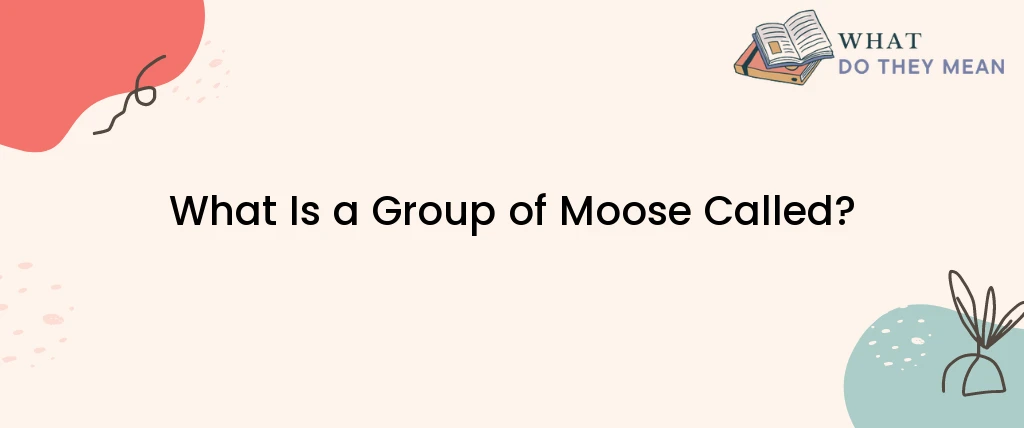Moose are majestic creatures that inhabit various parts of the world, known for their imposing size and antlers. These solitary animals can occasionally be spotted in groups, prompting the question: What is a group of moose called? In this article, we will delve into the fascinating world of moose herds and explore their social dynamics, behavior, and unique term used to describe a gathering of these magnificent animals.
The Terminology: A Group of Moose
A gathering of moose is referred to as a “herd.” This collective noun describes a group of these magnificent animals coming together. The term “herd” is commonly associated with various ungulates, including moose, and it signifies a temporary social unit formed by these solitary creatures.
Moose Herd Size and Composition
Moose herds can vary in size and composition. They can range from a few individuals to as many as 20 or more. The size of a moose herd is influenced by factors such as habitat availability, food resources, and the reproductive cycle. Female moose, known as cows, and their calves often form the core of a herd, while adult males, known as bulls, may join during the mating season.
Communication within Moose Groups
Communication plays a crucial role in moose herds. Although moose are not known for their vocalizations, they rely on various non-verbal cues to communicate with one another. These cues include body language, posturing, scent marking, and vocalizations such as grunts and bellows during the mating season.
The Benefits of Group Living for Moose
Group living offers several advantages for moose. By forming herds, they can benefit from increased vigilance against predators. Moose herds can also share knowledge about food sources and travel routes, allowing for more efficient foraging. In addition, the presence of other moose during the breeding season provides an opportunity for mating and passing on genetic traits.
Challenges of Group Living for Moose
While group living has its benefits, it also presents challenges for moose. Increased competition for food and mates can lead to conflicts within the herd. Dominance hierarchies may form, with dominant individuals prioritizing access to resources and mating opportunities. These hierarchical structures can influence the dynamics of the herd.
The Role of Dominance in Moose Herds
Within a moose herd, dominance plays a significant role. Dominant bulls often engage in displays of aggression, such as antler wrestling, to establish their status within the group. The dominant bull typically has the highest mating success and gains access to the most desirable breeding females.
Reproduction and Breeding Season
The breeding season, also known as the rut, is a crucial period for moose herds. Bulls compete for dominance and the opportunity to mate with receptive females. During this time, the vocalizations of moose intensify, and their behaviors become more territorial and aggressive.
The Life Cycle of a Moose
Moose go through various stages in their life cycle. They begin as calves, dependent on their mothers for nourishment and protection. As they grow, they become more independent and eventually reach adulthood. Moose have an average lifespan of 10 to 15 years in the wild, although some individuals have been known to live up to 20 years.
Moose Conservation Efforts
Conservation efforts play a vital role in protecting moose populations. Habitat preservation, responsible hunting practices, and monitoring population numbers are crucial for the long-term survival of these magnificent creatures. Additionally, educating the public about the importance of coexisting with wildlife can help minimize human-moose conflicts.
Human Interaction with Moose Groups
Human encounters with moose can occur, particularly in regions where their habitats overlap with human settlements. It is essential to remember that moose are wild animals and should be observed from a safe distance. Approaching or disturbing a moose can result in aggressive behavior, posing a threat to both humans and the moose themselves.
Interesting Facts about Moose
- Moose are the largest members of the deer family.
- Male moose have impressive antlers that can span up to six feet in width.
- Moose are excellent swimmers and can navigate through water with ease.
- Despite their large size, moose are surprisingly agile and can run at speeds of up to 35 miles per hour.
- Moose have a unique adaptation called a “bell,” a flap of skin hanging beneath their throat.
FAQs
No, moose herds are temporary and usually form during the breeding season or when food resources are abundant.
Moose cows typically give birth to one or two calves, usually in the spring.
Conclusion
In conclusion, a moose group is called a “herd.” While moose are generally solitary animals, they can unite temporarily to form social units. Herds provide various advantages, such as increased vigilance against predators and sharing of knowledge about resources. Understanding moose herds’ social dynamics and behavior allows us to appreciate the complexities of their lives and contributes to their conservation.

As a researcher, I am curious and driven by the pursuit of knowledge. I approach my work with a critical eye, carefully evaluating sources and methods to ensure that my findings are accurate and reliable. Whether delving into scientific studies, historical records, or cutting-edge technologies, I am always seeking to expand my understanding and make new discoveries. I am dedicated to uncovering new insights and finding solutions to complex problems, and am driven by a passion for uncovering the truth.

